Chinchillas
Chinchillas

Needs
Here’s a simple checklist to assist you in taking proper care of your chinchilla
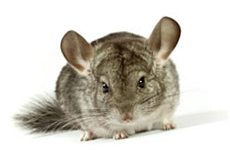
- Large, tall, multi-level cage
- Bedding
- Chewing blocks (for trimming of teeth)
- Water bottle
- Food bowl
- Nail clipper
- Bathing dust
- Bath house
- Toys
- Access to clean and fresh water
- Adequate and nutritious food
- Registered veterinarian consultation for regular checkups or medical treatment when the chinchilla is sick/injured
Above all, remember your chinchilla needs tender loving care!
Feeding
Chinchillas are herbivores. This means they are best fed on high fibre diet, which includes grass, vegetables and fruits. They also need to be supplemented with Vitamin C. They need a variety of food that is fresh to stay healthy. They can have tiny amount of fresh fruits and vegetables such as apples, carrots or Chinese cabbage. Your chinchilla should not have more than one teaspoon of snack. Snack can include raisins, dried fruits and sunflower seeds.
Supply your chinchilla with clean, fresh water at all times. Use a water bottle that can be hung on the cage. Be sure the tip of the water bottle is well-positioned for your chinchilla to reach easily. Change the water in the water bottle daily and keep the water bottle hygienic.
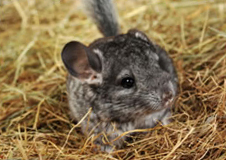
Chinchillas have teeth that grow continuously, so provide your chinchilla with a chewing block to gnaw on so that their teeth do not overgrow. You may need to bring it to the vet regularly so that the vet can check and trim your chinchilla’s teeth as needed.
It is best to feed your chinchilla at the same time every day, for example, in the late afternoon or early evening.
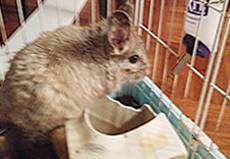
Accommodation
Chinchillas are active and acrobatic. They need a big enough cage to eat, sleep and exercise. The cage should also be tall and multi-level as chinchillas love to jump and climb. Chinchillas can be shy. Therefore, put a wooden box inside the cage so that your chinchilla can sleep and hide inside the box.
Chinchillas prefer cool, semi-arid climate and are sensitive to heat and humidity. They do not do well if temperature rises above 25 degrees. They are susceptible to heatstroke and related death. Therefore, make sure you put the cage in a cool, dry, well-ventilated, quiet and comfortable place indoors, out of direct sunlight. Use a fan, air-conditioner or dehumidifier to control the indoor climate for your chinchilla. If you use a fan, avoid direct draft.
The cage should be secure to prevent escape. You can use a wire mesh cage but make sure the mesh is small enough to avoid injuring your chinchilla’s feet and limb. Part of the floor should be solid.
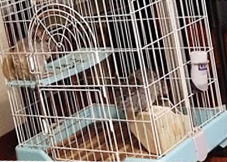
Line the cage with comfortable bedding which can absorb wet waste easily, such as those made from shavings, recycled or shredded paper. Dispose of soiled or wet bedding regularly. You should change all the bedding in the cage and wash the cage thoroughly weekly.
Cleaning and grooming
Give your chinchilla a dust bath several times a week. You will need to buy bathing dust and a bath house for their baths. You can buy them from local pet shops that sell chinchilla supplies. Never use beach sand. Put a small amount of bathing dust (about 2 to 3 cm deep) in a bath house that is big enough for your chinchilla to roll around in. These dust baths help remove excess oil and moisture in their fur and keep them clean. Remove the bath house after the bath and save it for next time. Remember to remove soiled dust immediately after use. Never bathe chinchillas in water as their coat absorbs water and is very difficult to dry out. Water in their fur may cause hypothermia which could be fatal.
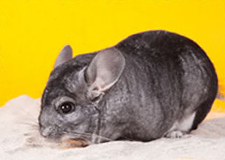
Interaction
Chinchillas are nocturnal, this means they are active at night and should be left alone to sleep during the day. It is best to play with them in the evening.
Chinchillas are usually easy to handle and seldom bite. However, they can be timid and panicky and unwilling to stay still for long periods. They can move fast. It is important to handle your chinchilla daily. Pick up your chinchilla gently by placing one hand under its chest and the other hand supporting its bottom. Never pick up your chinchilla by its tail. Once you have picked it up, hold it gently and securely against your chest or on your lap. If it struggles to get down once lifted, lower yourself and the chinchilla as close to the ground as possible to avoid falls and injuries.
It’s best to handle your chinchilla while you are sitting on the floor. This way, you can get down to your chinchilla’s level and let it get used to your presence. Allow the chinchilla to come to you and offer the back of your hand for it to sniff. Let it come to you on its own terms. Remember to be extra careful and gentle with your chinchilla as they can get stressed easily.
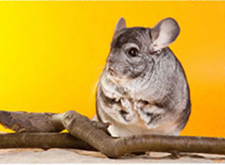
When you let your chinchilla out of the cage, make sure you watch over it. Chinchillas are difficult to toilet-train, so be ready to clean up after your chinchilla as it is likely to leave its droppings behind when it comes out of the cage. Chinchillas also love to chew so chinchilla-proof* your flat and cover electrical and phone cords with spiral cable wrap or plastic tubing if you let your chinchilla out of the cage to roam freely in your flat. Put household plants away and supervise your chinchilla when you let it out.
* It means keeping harmful chemicals (such as washing powder, bleach, etc.) and food and substances that are poisonous for chinchillas away.

